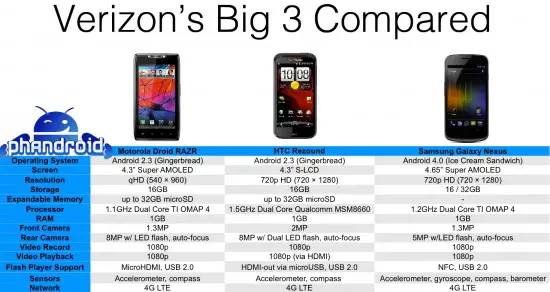Motorola Droid RAZR v. HTC Rezound v. Samsung Galaxy Nexus: Verizon’s Big 3 Compared
On the eve of the release of the Motorola Droid RAZR, many buyers in search of their next smartphone are faced with some serious decisions. Only a few days after Moto’s super-slim handset is released the similarly powerful HTC Rezound will hit shelves. Shortly after that comes the Samsung Galaxy Nexus. All three handsets feature 4G LTE connectivity, beautiful displays, and dual-core processors, but which truly rules Verizon’s holiday lineup?
As you can see from the above chart (click to get a bigger view), the handsets match each other nearly blow for blow in all the important categories. The Rezound holds an edge with a Qualcomm MSM8660 processor clocked at 1.5GHz per core, but it’s close. The Galaxy Nexus and Droid RAZR are clocked a bit slower, both utilizing a 1.2GHz OMAP 4 CPU. The Galaxy Nexus and Rezound are deadlocked with their 720p displays to the RAZR’s qHD offering, but the Nexus has the biggest screen at 4.65-inches. Size isn’t so much a plus, but it will sway some people’s decisions (though the Nexus manages to pack the large size in frame that still manages to not feel too big).
As has been harped on often enough, the true deciding factor is in the software. Android die-hards will want the Galaxy Nexus for its cutting edge Android 4.0 software and direct Google support. The every day user may not find this as big a selling point, especially considering Motorola and HTC’s use of custom software on top of Android 2.3. Other difference-makers include the RAZR’s 7.1mm chassis reinforced with steel and kevlar and the Rezound’s Beats Audio integration.
We can’t offer a definitive statement on the three until all have been thoroughly put through the paces, but at first glance none is the clear winner. Different aspects of each device will appeal to different users, but it’s hard to say going with any particular one would be the wrong choice.
